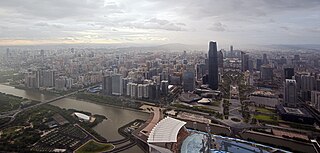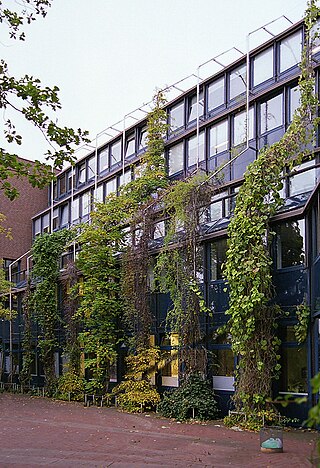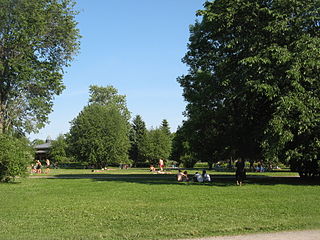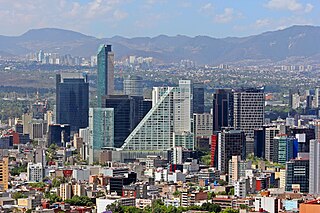Related Research Articles

Urban areas usually experience the urban heat island (UHI) effect, that is, they are significantly warmer than surrounding rural areas. The temperature difference is usually larger at night than during the day, and is most apparent when winds are weak, under block conditions, noticeably during the summer and winter. The main cause of the UHI effect is from the modification of land surfaces while waste heat generated by energy usage is a secondary contributor. A study has shown that heat islands can be affected by proximity to different types of land cover, so that proximity to barren land causes urban land to become hotter and proximity to vegetation makes it cooler. As a population center grows, it tends to expand its area and increase its average temperature. The term heat island is also used; the term can be used to refer to any area that is relatively hotter than the surrounding, but generally refers to human-disturbed areas. Urban areas occupy about 0.5% of the Earth's land surface but host more than half of the world's population.

Urbanization is the population shift from rural to urban areas, the corresponding decrease in the proportion of people living in rural areas, and the ways in which societies adapt to this change. It can also mean population growth in urban areas instead of rural ones. It is predominantly the process by which towns and cities are formed and become larger as more people begin living and working in central areas.

In general, a rural area or a countryside is a geographic area that is located outside towns and cities. Typical rural areas have a low population density and small settlements. Agricultural areas and areas with forestry are typically described as rural, as well as other areas lacking substantial development. Different countries have varying definitions of rural for statistical and administrative purposes.

Urban ecology is the scientific study of the relation of living organisms with each other and their surroundings in an urban environment. An urban environment refers to environments dominated by high-density residential and commercial buildings, paved surfaces, and other urban-related factors that create a unique landscape. The goal of urban ecology is to achieve a balance between human culture and the natural environment.

Urban forestry is the care and management of single trees and tree populations in urban settings for the purpose of improving the urban environment. Urban forestry involves both planning and management, including the programming of care and maintenance operations of the urban forest. Urban forestry advocates the role of trees as a critical part of the urban infrastructure. Urban foresters plant and maintain trees, support appropriate tree and forest preservation, conduct research and promote the many benefits trees provide. Urban forestry is practiced by municipal and commercial arborists, municipal and utility foresters, environmental policymakers, city planners, consultants, educators, researchers and community activists.

A living street is a street designed with the interests of pedestrians and cyclists in mind by providing enriching and experiential spaces. Living streets also act as social spaces, allowing children to play and encouraging social interactions on a human scale, safely and legally. Living streets consider all pedestrians granting equal access to elders and those who are disabled. These roads are still available for use by motor vehicles; however, their design aims to reduce both the speed and dominance of motorized transport. The reduction of motor vehicle dominance creates more opportunities for public transportation.

Suburbanization (AE), or suburbanisation (BE), is a population shift from historic core cities or rural areas into suburbs, resulting in the formation of (sub)urban sprawl. As a consequence of the movement of households and businesses away from city centers, low-density, peripheral urban areas grow.
The social determinants of health (SDOH) are the economic and social conditions that influence individual and group differences in health status. They are the health promoting factors found in one's living and working conditions, rather than individual risk factors that influence the risk or vulnerability for a disease or injury. The distribution of social determinants is often shaped by public policies that reflect prevailing political ideologies of the area.

In medicine, rural health or rural medicine is the interdisciplinary study of health and health care delivery in rural environments. The concept of rural health incorporates many fields, including wilderness medicine, geography, midwifery, nursing, sociology, economics, and telehealth or telemedicine.

Greening is the process of transforming living environments, and also artifacts such as a space, a lifestyle or a brand image, into a more environmentally friendly version. The act of greening generally involves incorporating more environmentally friendly systems into one's environment, such as the home, work place, and general lifestyle.
Residential segregation is the physical separation of two or more groups into different neighborhoods—a form of segregation that "sorts population groups into various neighborhood contexts and shapes the living environment at the neighborhood level". While it has traditionally been associated with racial segregation, it generally refers to the separation of populations based on some criteria.

In land-use planning, urban green space is open-space areas reserved for parks and other "green spaces", including plant life, water features - also referred to as blue spaces - and other kinds of natural environment. Most urban open spaces are green spaces, but occasionally include other kinds of open areas. The landscape of urban open spaces can range from playing fields to highly maintained environments to relatively natural landscapes.

Housing inequality is a disparity in the quality of housing in a society which is a form of economic inequality. The right to housing is recognized by many national constitutions, and the lack of adequate housing can have adverse consequences for an individual or a family. The term may apply regionally, temporally or culturally. Housing inequality is directly related to racial, social, income and wealth inequality. It is often the result of market forces, discrimination and segregation.
The social determinants of health in poverty describe the factors that affect impoverished populations' health and health inequality. Inequalities in health stem from the conditions of people's lives, including living conditions, work environment, age, and other social factors, and how these affect people's ability to respond to illness. These conditions are also shaped by political, social, and economic structures. The majority of people around the globe do not meet their potential best health because of a "toxic combination of bad policies, economics, and politics". Daily living conditions work together with these structural drivers to result in the social determinants of health.

Open spaces in urban environments, such as parks, playgrounds, and natural areas, can provide many health, cultural, recreational, and economic benefits to the communities nearby. However, access to open spaces can be unequal for people of different incomes. In California's two largest metropolitan regions, Los Angeles County in Southern California and the Bay Area in Northern California, access to green space and natural areas varies with the predominant races and classes of the communities. This also holds true in San Diego County in Southern California. Both expanding urbanization and diminishing funding for open space tend to widen these gaps in accessibility. Because open space is associated with various mental and physical benefits, a lack of access to it can pose health consequences. However, more research is needed to determine whether such environmental inequalities translate into long-term health inequalities, and, if so, how.
Environmental, ecological or green gentrification is a process in which cleaning up pollution or providing green amenities increases local property values and attracts wealthier residents to a previously polluted or disenfranchised neighbourhood. Green amenities include green spaces, parks, green roofs, gardens and green and energy efficient building materials. These initiatives can heal many environmental ills from industrialization and beautify urban landscapes. Additionally, greening is imperative for reaching a sustainable future. However, if accompanied by gentrification, these initiatives can have an ambiguous social impact. For example, if the low income households are displaced or forced to pay higher housing costs. First coined by Sieg et al. (2004), environmental gentrification is a relatively new concept, although it can be considered as a new hybrid of the older and wider topics of gentrification and environmental justice. Social implications of greening projects specifically with regards to housing affordability and displacement of vulnerable citizens. Greening in cities can be both healthy and just.

Mexico City has massively been expanding its urban fabric and population density, becoming the fifth largest city in the world. A combination of neoliberal policies, complex geographic location, socio-economic disparities and inefficient strategies have influenced the process of gentrification en la city. The combination of numerous megaprojects and inefficient city-planning strategies have led to dysfunctions in circulation, community allocation and equal access to resources. In consequence, middle and low-income communities have been directly or indirectly alienated and challenged to adapt to a complex and evolving urban environment.
The COVID-19 pandemic has had an unequal impact on different racial and ethnic groups in the United States, resulting in new disparities of health outcomes as well as exacerbating existing health and economic disparities.
Environmental racism is a form of institutional racism, in which people of colour bear a disproportionate burden of environmental harms, such as pollution from hazardous waste disposal and the effects of natural disasters. Environmental racism exposes Native Americans, African Americans, Asian Americans, Pacific Islanders, and Hispanic populations to physical health hazards and may negatively impact mental health. It creates disparities in many different spheres of life, such as transportation, housing, and economic opportunity.
Urban forest inequity, also know as shade inequity or tree canopy inequity, is the inequitable distribution of trees, with their associated benefits, across metropolitan areas. This phenomenon has a number of follow-on effects, including but not limited to measurable impacts on faunal biodiversity and the urban heat island effect. Urban heat inequity occurs when intra-urban heat islands, with their associated negative physical and emotional health consequences, are more common and more intense in lower-income communities.
References
- 1 2 3 4 5 6 7 8 Chen, Peng (January 2024). "Inequality in heat: The role of spatial patterns of urban green infrastructure". Urban Climate. 53: 101820. Bibcode:2024UrbCl..5301820C. doi:10.1016/j.uclim.2024.101820.
- 1 2 Lin, Jian; Zhang, Hongsheng; Chen, Min; Wang, Qiang (May 2023). "Socioeconomic disparities in cooling and warming efficiencies of urban vegetation and impervious surfaces". Sustainable Cities and Society. 92: 104464. doi:10.1016/j.scs.2023.104464. ISSN 2210-6707.
- 1 2 Keith, Ladd; Gabbe, C.J.; Schmidt, Erika (2023-09-03). "Urban heat governance: examining the role of urban planning". Journal of Environmental Policy & Planning. 25 (5): 642–662. Bibcode:2023JEPP...25..642K. doi:10.1080/1523908X.2023.2244446. ISSN 1523-908X.
- 1 2 Mitchell, Bruce Coffyn; Chakraborty, Jayajit (2018-08-03). "Exploring the relationship between residential segregation and thermal inequity in 20 U.S. cities". Local Environment. 23 (8): 796–813. Bibcode:2018LoEnv..23..796M. doi:10.1080/13549839.2018.1474861. ISSN 1354-9839.
- 1 2 3 4 5 6 7 8 9 10 11 12 13 14 15 16 17 Lo, Alex Y.; Jim, C.Y.; Cheung, Pui Kwan; Wong, Gwendolyn K.L.; Cheung, Lewis T.O. (August 2022). "Space poverty driving heat stress vulnerability and the adaptive strategy of visiting urban parks". Cities. 127: 103740. doi:10.1016/j.cities.2022.103740. ISSN 0264-2751.